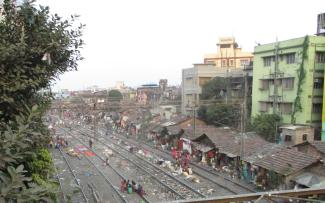Urbanisation
Crowded spaces

Janki Prasad, 40, and her three children live in a small room covered with a tin roof. A broken wooden door marks the entrance. This hut has barely enough space for two people. A brick wall separates the living space from the street outside, where an open drain runs parallel to a walking path. In the rainy season, the area is flooded.
Janki’s home is one of many in Seelampur, a slum in Delhi. She says it is better to live here than in the village she comes from. It is 600 kilometres away, and she is happy to see her husband daily. He works in the capital region, and she is also earning some money as a cook. The children go to school. Their housing situation is tough, but Janki considers that she has more and better opportunities in the city than those available in her village.
She is actually one of the more fortunate slum dwellers because she shares a “toilet” with a neighbour. It is a makeshift tent with wooden planks as pillars and old bed sheets as walls. It is not connected to the sewerage system, and its waste goes into an open drain.
Most people in Seelampur use community toilets on the fringes of the slum. These toilets are not cleaned regularly, and women find it embarrassing to go there since they only get minimum privacy from men and boys.
Search of opportunities
India is home to more than 65 million slum dwellers. They live in more than 100,000 informal urban settlements. Over a third live in slums that are not officially recognised.
Ever more people are moving to the cities in the hope of better opportunities. In the past two decades, India's urban population increased by 160 million to 377 million, according to a UN report, and some 600 million people are expected to live in India’s 8,000 cities and towns by 2031.
Only half of the cities and towns have local-government bodies of their own. The census of 2011 only counted slums in these so-called statutory towns, because the other towns lacked the authority to report slums. For many official purposes, slums are often simply ignored.
There are three official classifications for slums: “notified”, “recognised” and “identified”. The first two categories mean that some official authority has designated the area as a slum. The third category, however, only means that at least 300 people are living in at least 60 tenements. An “identified” slum has no legal status and does not get municipal services. More than 1million of New Delhi’s about 1.7 million slum dwellers live in such conditions. India’s other megacities such as Mumbai, Kolkata and Bangalore also have huge slum populations.
Indian urbanisation has been largely unplanned and haphazard. That is typical of many developing countries. Masses of people live in marginalised settlements that do not match officialdom’s idea of what a proper city should look like.
"World-class city"
In Delhi, town planners and policymakers have promoted visions of a “world-class city” without slums. They argue that an “efficient land market” could convert “under-utilised” public land, which is currently occupied by slum dwellers, into commercially exploitable real estate. Their idea of urban development is to evict most shanty towns and upgrade some of them.
The Delhi Development Authority (DDA) spelled out such plans in 1997. Ahead of the Commonwealth Games in 2010, it forcefully evicted large numbers of urban poor and demolished their homes. In the DDA perspective, slums should generally not be accepted.
In recent decades, Indian courts have increasingly shared that view. Asher Ghertner, a geographer form Rutgers University in the USA, has written about “the judiciary’s expanded role in demanding slum clearance” in his book “Rule by aesthetics: world-class city making in Delhi”.
This phenomenon seems to be prevalent across the country. In a 2017 ruling, the Bombay High Court decided that slum dwellers who had encroached on railway land had to pay a fine. The families had lived there for decades. Nonetheless, the judges argued that, “the very act of encroaching upon railway property (is) a punishable offence”.
Historically, India’s slums often grew on public land, including railway property for example. Government agencies mostly chose to tolerate them. After all slum dwellers are potential voters. Nonetheless, the residents of informal settlements were never free to manage their affairs as they thought was best. Informal settlements are controlled by mafia-like networks of slum lords who typically have some links to corrupt politicians. The poor people pay hefty rents for their miserable homes. They are also charged for the minimal basic services they get. Slums are part of the informal economy in which “might makes right”.
Ghertner, the American geographer, notes that public attitudes have been increasingly turning against slums. Many court cases that resulted in slum evictions in Delhi started as public interest litigation (PIL). PIL means that a court accepts a case that was filed by citizens not pursuing their personal interest, but claiming to represent the public good. Better-off residents are filing such cases against shanty towns, considering the poor people’s homes a public nuisance.
According to the landmark ruling of the Bombay High Court in the Olga Tellis case in 1985, government bodies may evict slum dwellers in spite of people’s constitutional right to life and livelihood. However, the state agencies must act in accordance with the law and consider the slum dwellers’ situation. In practice, such consideration is minimal. In the Olga Tellis case, it meant waiting until the rainy season was over. Evicted people, moreover, were not entitled to new homes.
In-situ rehabilitation
Even well-intended policies sometimes go wrong. The Delhi Master Plan 2021, which was published in 2007, introduced an “in-situ rehabilitation” approach for the redevelopment of slums. The first slum chosen to be improved this way was Kathputli Colony, which Salman Rushdie immortalised in his famous novel “Midnight’s children”.
Kathputli was a designated slum area, so the people living there had right of tenure. Nonetheless, they were evicted and forced to move to a different place in 2014. Media attention did not help. Now the reallocation of some 1,000 new flats to some of the evicted people has begun. The new flats are not where the former slum cluster was, however, and the former residents feel they are being cheated. They have been expressing their concerns by writing to various government authorities.
In-situ rehabilitation is possible in principle. It requires taking into account the needs of the local people (see Diana Mitlin in D+C/E+Z e-Paper 2016/10, page 24 and D+C/E+Z print edition 2016/11-12, page 13), which typically differ from town planners’ preconceptions (see Rüdiger Korff in D+C/E+Z e-Paper 2016/10, page 28 and D+C/E+Z print edition 2016/11-12, page 19). The results of such measures suit the residents, but do not necessarily conform with ideas of “world class”.
India’s central government is aware of the challenges. Prime Minister Narendra Modi has said: “We have a dream that by 2022, every Indian should have his own house with the facilities of electricity, water and nearby hospitals. No one should be homeless.”
The proposed National Urban Rental Housing Policy 2017 could be a game changer. It proposes that slums on municipal land be granted security of tenure under the condition that they are converted into rental housing. Municipal bodies would assume the landlord role and be bound by social principles. According to the Ministry of Housing and Urban Poverty Alleviation, the policy will not only protect slum residents from the threat of constant eviction and demolition but also act as a source of significant revenue for the urban local bodies. Housing Minister M. Venkaiah Naidu said in April 2017 that this policy “aims at meeting the growing housing needs of migrants, students, single working women and others”.
The approach makes sense. Nonetheless, some observers doubt it will work out. One reason to worry is the experience of Kathputli Colony. After all, the DDA approach of in-situ rehabilitation is in line with what the central government is planning, but it failed.
In more general terms, Mukta Naik, a senior researcher at the Centre for Policy Research, an independent think tank, argues that the new policy does not include an unconditional no-eviction guarantee. In her eyes, this lack reveals “the failure to recognise informal housing for what it is, to accept that slums are providing affordable housing which should have been provided by the state”. She concludes that the state still considers slum dwellers to be encroachers rather than people who need homes.
Indian cities are witnessing a building spree, but most projects only cater to the middle-income and affluent population. Demand for land is great. Manish Kumar, the manager of a private-sector real-estate consultancy says: “Home prices have gone beyond the reach of many.” He sees a lack of affordable housing which results from the lack of both land and loans at reasonable rates.
Roli Mahajan is a freelance journalist who lives in Delhi.
roli.mahajan@gmail.com








